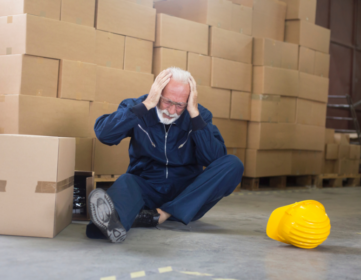How to prevent head injuries this winter
On a busy stage or set, there are countless props or pieces of equipment that could cause serious injury if they are not properly secured or. attended to. Whether it’s props, lighting, or camera equipment, using personal protective equipment (PPE) such as safety headgear has always been a useful way to reduce the risk of head injuries from falling, flying, or thrown objects. But in September 2021, there were changes to the Occupational Health and Safety Regulation that require employers to follow the hierarchy of controls when managing the risk of head injury. These changes are described in the WorkSafeBC publication Regulatory amendment: A primer on safety headgear. Following the hierarchy means first trying to eliminate the risk of falling, flying, or throwing objects rather than defaulting to using PPE such as hard hats. Why? Because PPE does not eliminate or minimize a hazard—it simply puts a barrier between the hazard and the worker.
During the winter months, reduced daylight and decreased visibility make it even more important to ensure that safety measures are in place to protect crew members. Before work begins, take time to understand the risk of head injuries to your workers by completing a risk assessment. Do the set layout, work tasks, or activities put anyone at risk of a head injury from falling, flying, or thrown objects? Document all the potential hazards and then assess the risk. Encourage crew members to be a part of this process as they can provide valuable insights into the level of risk if they
are exposed to a hazard.
Once you’ve identified and assessed the risks, you can then determine how best to implement controls to eliminate or reduce the risk of head injury. If you cannot eliminate the risk, then you must apply engineering or administrative controls to reduce it. If it is
not practical to eliminate the risk or reduce it to the lowest level possible using other controls, then workers must wear appropriate safety headgear. Follow the hierarchy when considering possible risk controls:
1. Elimination
2. Substitution
3. Engineering control
4. Administrative control
5. PPE
While hard hats are frequently used as a protective device in many situations, completing a hazard and risk assessment and following the hierarchy of controls will help ensure that the correct level of protection is used to protect workers from injury. It also ensures that worker rights are respected and that workplaces consider suitable, safe options for those who may not be able to wear a hard hat because they wear religious headwear. If you or one of your workers is not able to wear a hard hat, speak to your employer about the options available to ensure a safe workplace. If a hard hat is needed, employers may have to offer other accommodations to ensure the safety of the crew member.

LEARN MORE
WorkSafeBC has created an OHS guideline to help you understand this new regulatory requirement and to provide support in identifying and controlling the risk of head injury from overhead hazards. You can find more resources on WorkSafeBC’s Safety Headgear page, including how to choose the right type of safety headgear, and by using their risk management template.
Download Infographic: Concussion Awareness, Response and Management for the Motion Picture, Film & Live Performance Industries


